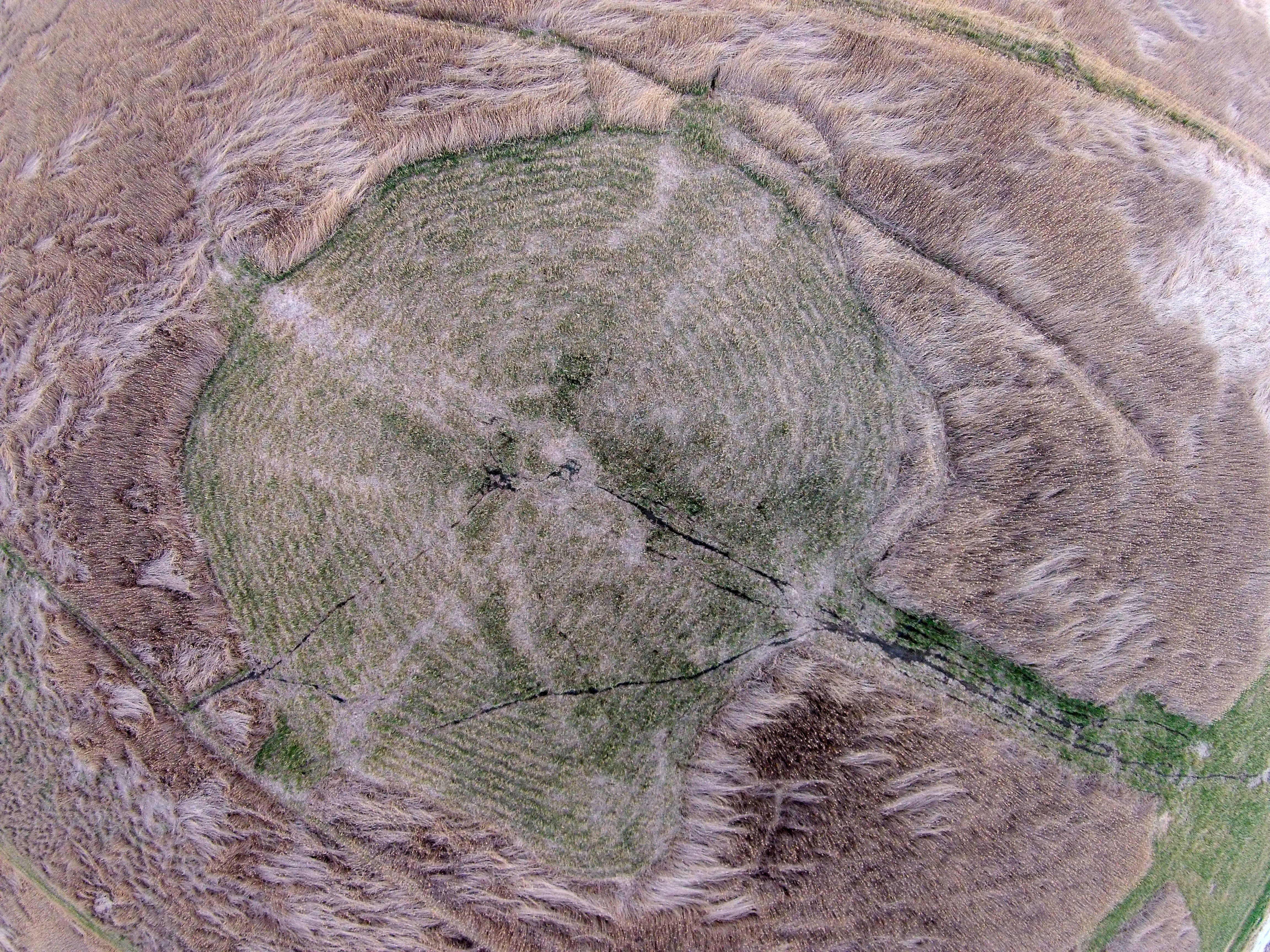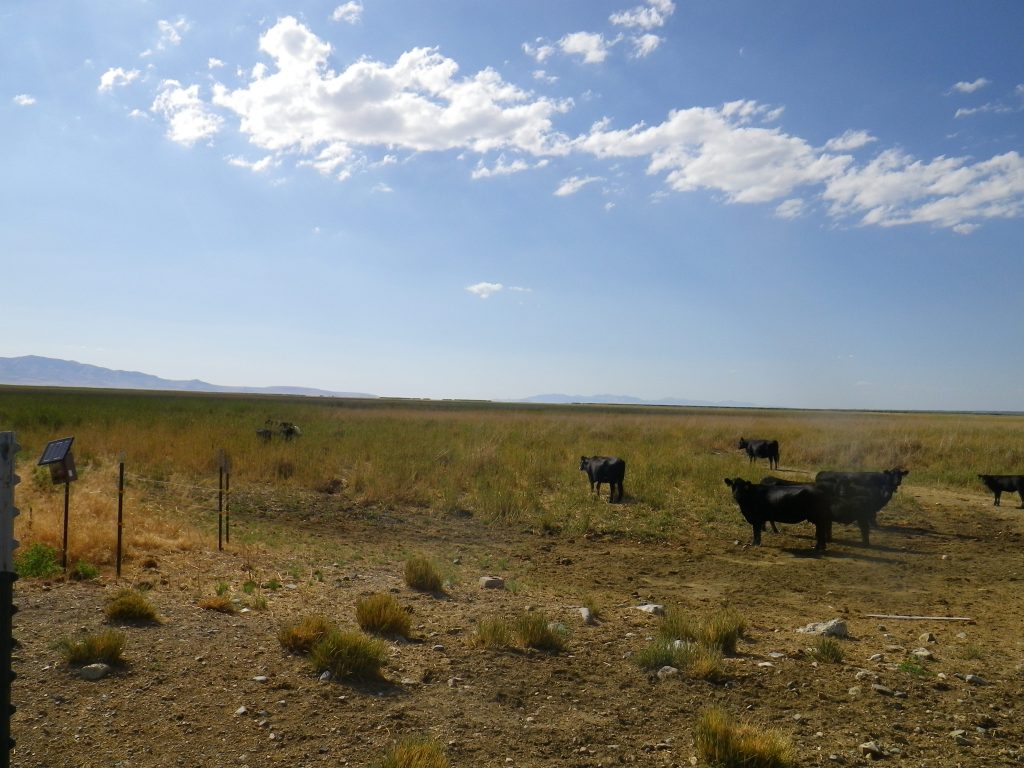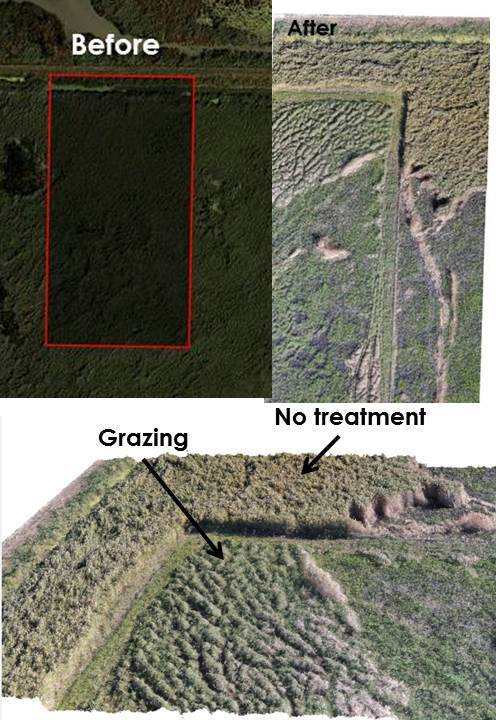July 27, 2016
Story and photos by Becka Downard, Utah State University.

An aerial drone view of Phragmites stands that have been grazed by cattle.
Summary
This case study takes us outside of the Great Lakes region to explore an unusual Phragmites management technique. Becka Downard is a PhD student who studies Great Salt Lake wetlands, and found her fieldwork increasingly interrupted by expanding stands of Phragmites. She learned that land managers were experimenting with the use of using grazing cattle to control large and remote Phragmites stands, and began using drone photography to document these sites. She is now using drone imagery to build a 3D model and evaluate the effectiveness of cattle grazing to control Phragmites.
 Fighting Phragmites with Hungry Cattle
Fighting Phragmites with Hungry Cattle
If you look down next time you fly into Salt Lake City you can see the extent of the Phragmites problem around Great Salt Lake as well as a unique treatment: cattle. This research project explores the effects of cattle grazing on over 7,500 acres this summer.
Phragmites has invaded more than 26,000 acres of Great Salt Lake wetlands. Every year the Utah Division of Wildlife Resources treats more than 10,000 acres of Phragmites on public lands with herbicide; this in addition to treatments on private hunting clubs and conservation areas. Multiple years of treatment has shown some success in eliminating Phragmites, but the large amounts of standing dead stems left following treatment prevent regeneration of native species. In the past, managers used controlled burns to remove that biomass, but air quality restrictions along populated areas of northern Utah currently prevent public agencies from conducting most large burns. Instead, a growing number of federal, state, and private land managers have turned to cattle to remove living Phragmites from their marshes.
Small-scale grazing in Great Salt Lake wetlands has historically been used to open up dense stands of vegetation for nesting birds or hunting access. Since 2007, cattle have been used on a larger scale to open up Phragmites marshes and hopefully allow the recruitment of native species. This summer more than 7,500 acres of living Phragmites stands will be grazed. After nesting birds leave in early June, managers draw down water levels and put up temporary fencing to concentrate cattle on the wetlands to be treated. Local cattle owners bring in cattle and herd them as necessary, ensuring they have adequate forage and water. Cattle can spend 2-3 months on the marsh and are removed in late summer.
 Effectiveness Study
Effectiveness Study
So, how effective is cattle grazing to fight Phragmites? To monitor changes in Phragmites change within 25-acre plots, I’m using a drone to build 3-dimensional models to estimate the total volume grazed. Structure-from-Motion software merges the images taken by the drone into two 3D models which reflect the height of the Phragmites and the ground surface. We can then overlay these 3D models to compare control plots with the amount of Phragmites left after the hungry cattle have finished their work. This 3D modelling will give us a much bigger picture of the cattle’s impact on the Phragmites stands.
At the same time, my colleague Brittany Duncan (a Master’s student at Utah State University) is conducting research on the effectiveness of grazing for Phragmites control as well as the impacts on nutrient cycling.
Results
Results are preliminary, but it looks like a combination of grazing, herbicide, and flooding treatments are required to truly control Phragmites. We hope that by the conclusion of the project we can provide guidance on where and how to best utilize cattle in the fight against Phragmites.
Further Reading
Long, Arin Lexine, “Distribution and Drivers of a Widespread, Invasive Wetland Grass, Phragmites australis, in Great Salt Lake Wetlands” (2014). All Graduate Theses and Dissertations. Paper 3869. http://digitalcommons.usu.edu/etd/3869
Kettenring, K.M., C.B. Rohal, C. Cranney, and E.L.G. Hazelton. 2014. Assessing approaches to manage Phragmites in Utah wetlands. Final report to the Utah Division of Wildlife Resources, Division of Wildlife Resources. 12 pp. Link.
Becka Downard is a PhD candidate at Utah State University. You can learn more about her research on her Kettenring Wetland Ecology Lab website or her personal blog.
